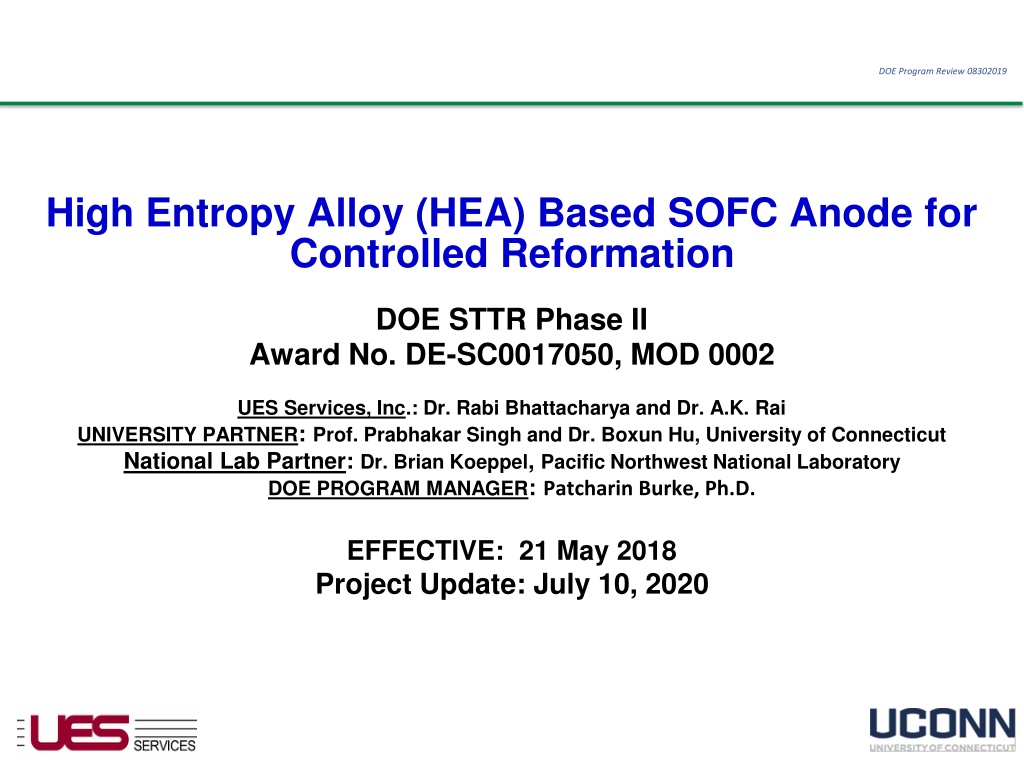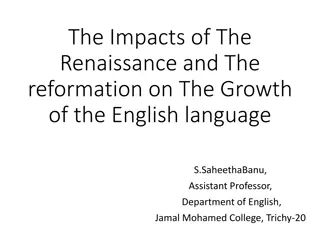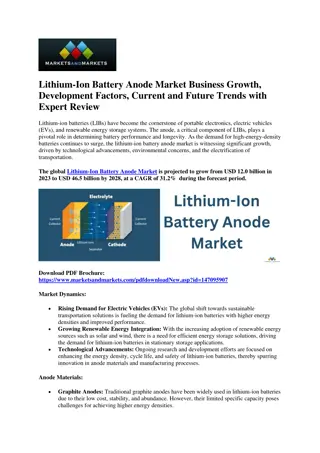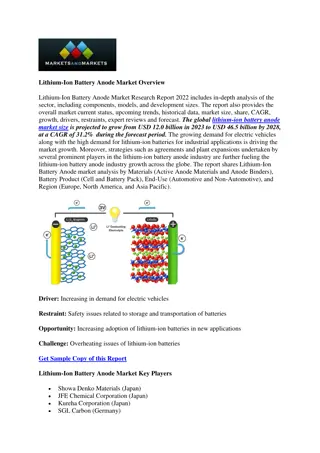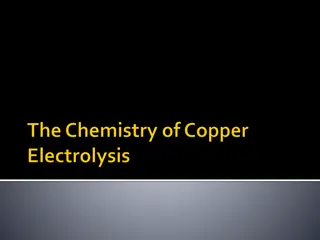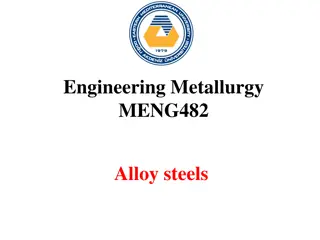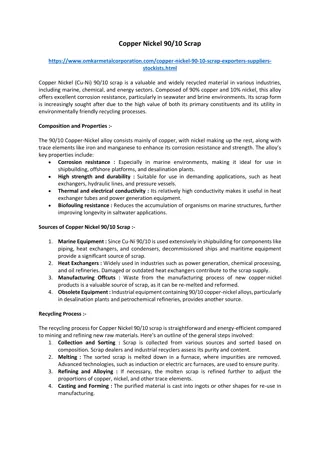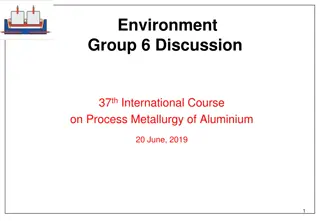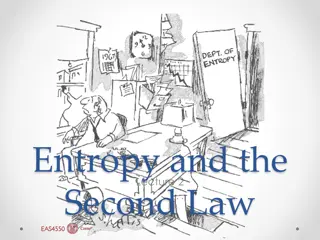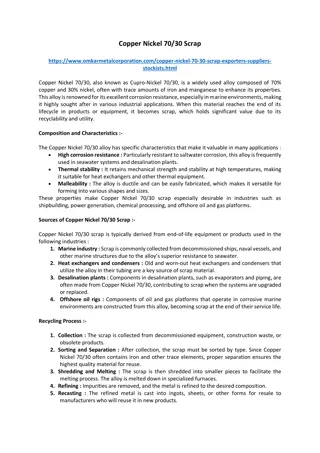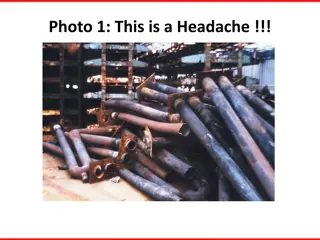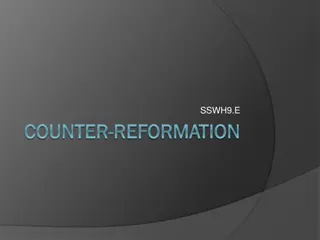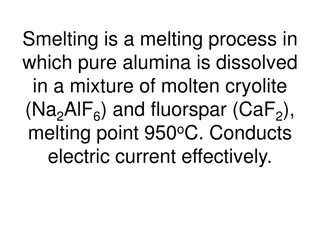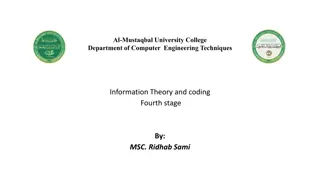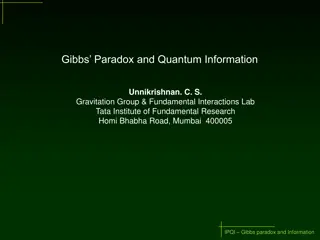Development of High Entropy Alloy-Based SOFC Anode for Controlled Reformation
Development and testing of a High Entropy Alloy-based Solid Oxide Fuel Cell (SOFC) anode for controlled reformation to improve thermal performance, reduce carbon deposition, and enhance durability. The project involves fabricating cells, electrochemical testing, modeling reformation rates, and scaling up the synthesis process. Results show successful carbon-resistant reformation with HEA catalysts, minimal carbon deposits, and improved stability in DIR-SOFCs, promising lower costs and enhanced efficiency.
Download Presentation

Please find below an Image/Link to download the presentation.
The content on the website is provided AS IS for your information and personal use only. It may not be sold, licensed, or shared on other websites without obtaining consent from the author. Download presentation by click this link. If you encounter any issues during the download, it is possible that the publisher has removed the file from their server.
E N D
Presentation Transcript
DOE Program Review 08302019 High Entropy Alloy (HEA) Based SOFC Anode for Controlled Reformation DOE STTR Phase II Award No. DE-SC0017050, MOD 0002 UES Services, Inc.: Dr. Rabi Bhattacharya and Dr. A.K. Rai UNIVERSITY PARTNER: Prof. Prabhakar Singh and Dr. Boxun Hu, University of Connecticut National Lab Partner: Dr. Brian Koeppel, Pacific Northwest National Laboratory DOE PROGRAM MANAGER: Patcharin Burke, Ph.D. EFFECTIVE: 21 May 2018 Project Update: July 10, 2020
Outline DOE Program Review 08302019 Phase II Program Plan Significance and Problem Statement Summary of Results Reported in 2019 Program Review Accomplishments During Current Reporting Period Cell Fabrication: Screen-printing-Magnetron Sputter Co- Deposition Electrochemical Testing Modeling the effect of on-cell reformation rate on cell thermal gradient Future Work Acknowledgements 2
Phase II Program Plan DOE Program Review 08302019 1. Develop electrochemical and thermal model of the cell in its stack environment for selected reformation rates that may be controlled by HEA-anode composition. 2. Cell Fabrication, Electrochemical Testing and Performance Analysis: This task will focus on fabricating button cells using standard Cermet processing of HEA/YSZ,GDC, electrical testing of fabricated cells, comparison of performance with base line cell and performance analysis (electrode polarization, gas analysis, and structural changes). 3. Develop HEA-YSZ Anode by Magnetron Sputter Deposition and Fabricate Cells for Electrochemical Testing: Co-deposition of HEA and YSZ from a composite target will allow deposition of anode directly on the electrolyte. 4. Testing of Cells Fabricated by Magnetron Sputtering of HEA/YSZ or GDC Anode Cells will be fabricated by direct deposition of HEA/YSZ or GDC anode by sputtering on conventionally processed electrolyte and tested. 5. Scale up HEA synthesis process 6. Demonstrate long term stable C free operation 7. Demonstrate long term stable C free operation 8. Technology transfer and commercialization
Significance and Problem Statement DOE Program Review 08302019 Problem statement Local cooling or overheating resulting in mechanical failure due to thermally induced stresses. Carbon deposits in the anode leads to anode deactivation. High operating temperature materials & system degradation Durability for long term operation Impact and significance Low cost High Entropy Alloy (HEA)-based anode has been developed for carbon-resistant distributed internal reforming (DIR)-SOFCs. Improve temperature profile across the anode by controlled reforming. Increase the stability and reduce the SOFC cost.
Summary of Results Reported in 2019 Program Review DOE Program Review 08302019 Controlled reforming using HEA catalysts has been achieved and confirmed by gas chromatographic analysis in hydrocarbon fuel reforming reactions. Carbon deposits were not observed on HEA/GDC during exposure to CH4 and methanol reformation at 750 C whereas carbon formed on traditional Ni/GDC catalysts at C/S ratio of 1:1. Carbon deposits were not observed on the HEA-GDC anode during cell validation using methane fueled DIR-SOFCs at 750 C whereas significant amount of carbon formed on standard Ni-GDC anode. The HEA-based DIR-SOFC shows stable performance in a 50-h test. High entropy alloys (HEA) can be used to significantly improve the carbon tolerance of the Ni-based catalyst. Magnetron sputter deposition of HEA on sol-gel processed GDC anode showed promising results. 5
Accomplishments During Current Reporting Period DOE Program Review 08302019 The effect of different reforming rates on thermal gradients in planar cells was evaluated by numerical modeling. PNNL s SOFC-MP 2D code was used to evaluate the temperature difference on the entire stack and individual cells within a tall stack as a function of different methane reformation rates. The results generally demonstrated that reduction of the reformation rate to 50%- 75% of the nominal rate was beneficial and reduced the temperature difference in the cells and stack. Select anode materials have been integrated in button cells, which have demonstrated carbon-tolerance and stable electrochemical performance up to 100-hour cell tests. Various characterization techniques have been utilized to develop mechanistic understanding of structure-performance relationship. Prepared patent disclosure on the use of HEA as SOFC anode
Anode Synthesis by Magnetron Sputtering DOE Program Review 08302019 HEA-GDC and HEA-YSZ anodes were synthesized by magnetron sputtering Button cells were prepared by using 2.5 cm diameter YSZ discs as substrate LSM-YSZ cathode layer was deposited by screen printing method Porous GDC layer was deposited on the other side of the YSZ substrate also by screen printing method Selected HEA layer of various thicknesses was deposited on GDC by magnetron sputtering Electrochemical performance of the cells were tested Pre-test and post-test button cells were characterized by using various techniques
Electrochemical Performance Analysis DOE Program Review 08302019 Button Cell Fabrication-Method 2.5 cm diameter A: Screen printing of LSM-YSZ Cathode B. Sintered at 1050 C for 2 h C: Screen printing of porous GDC support E. Magnetron Sputter Co-Deposition of HEA on GDC support E. Au gauze/wires Calc. at 800 C for 1 h F. Sealed a cell on Al2O3 tube with paste
Characterization of Pre-test Button Cells DOE Program Review 08302019 Element Weight % Atomic % Error % O K 22.80 72.70 8.90 Ce L 59.90 21.80 4.90 Gd L 17.20 5.60 16.20
Characterization of Pre-test Button Cells DOE Program Review 08302019 70000 Screen-printed GDC side 60000 GDC HEA + GDC 50000 Instensity (cps) 40000 30000 20000 Screen-printed LSM-YSZ side 10000 0 10 20 30 40 2 (Degree) 50 60 70 80 90 Sputtering coated HEA on the GDC side 1 m 2 m HEA thickness 4 m
Electrochemical Performance Analysis DOE Program Review 08302019 Button Cell Validation by Electrochemical Testing Gas chromatograph Furnace & Reactor Bio-logic potentiostat/ Galvanstat Desk PC Fuel pump Outlet to GC analysis Humidity sensor
Characterization of Posttest SOFC DOE Program Review 08302019 Pt paste HEA GDC Porous GDC HEA Porisity of HEA to be improved Carbon deposits is not observed on posttest HEA-GDC anode in 20% CH4/20%H2O after 100 h at 750 C.
Electrochemical Performance DOE Program Review 08302019 Initial oxidation of the HEA in steam lead to degradation, then stable electrochemical performance for 100 hours. Carbon deposits is not observed on posttest HEA-GDC anode in 20% CH4/20%H2O after 100 h at 750 C. Measured OCV of the cell in CH4 fuel is close to theoretical OCV.
Deposition of Porous Anode Layer by Magnetron Sputtering DOE Program Review 08302019 Thin film (TF) SOFC is attractive because they can be operated at lower temperature Magnetron sputtering is scalable, thus promising for making all-sputtered TF-SOFC Towards that goal, we developed the process of deposition of a porous YSZ-HEA anode layer on dense YSZ electrolyte substrate b a c Cross-section SEM image (a), EDS analysis (b) and Surface (c) of a co-sputtered HEA- YSZ film on dense YSZ disc showing porous columnar nano-structure having diameter of tens of nanometers, thus creating a very large active surface area. 14
Summary of Results of Sputtered HEA Coatings DOE Program Review 08302019 HEA-based DIR-SOFC shows stable performance in a 100-h test though some delamination of sputtered coatings was observed. High entropy alloys (HEA) can be used to significantly improve the carbon tolerance of the Ni-based catalyst. It is proposed to use thinner HEA layers, <1 m, to improve performance and adherence of the sputtered HEA layer to GDC HEA layers of thickness 200 to 1000 nm were deposited on button cells prepared the same way as described above These button cells are waiting to be tested once the UC Laboratory is open Co-sputtering of porous HEA-YSZ anode layer is developed 15
Numerical Modeling of different reforming rates on thermal gradients in planar cells (Subcontract to PNNL): Model Summary The effect of different reforming rates on thermal gradients in planar cells was evaluated by numerical modeling. PNNL s SOFC-MP 2D code was used to evaluate the temperature difference on individual planar cells and the entire stack as a function of different methane reformation rates. The evaluated rate was linearly scaled from 10%-500% from the nominal value given by an expression derived that has first order dependence with methane partial pressure and an Arrhenius relationship for dependence on temperature. The baseline stack was a single 10 10 cm co-flow cell in an adiabatic environment. Sensitivity analyses were performed to identify the influence of several parameters: DOE Program Review 08302019
Numerical Modeling of different reforming rates on thermal gradients in planar cells (Subcontract to PNNL): DOE Program Review 08302019 Model Summary Sensitivity analyses were performed to identify the influence of several parameters: flow orientation: co-flow, counter-flow stack cell count: 1, 10, 30, 100 external thermal environment: adiabatic, furnace, enclosure inlet fuel composition: wet H2, 6% CH4, 12% CH4 cell size: 10, 15, 20, 40 cm The results from the 2D model generally demonstrated that reduction of the reformation rate to 50%-75% of the nominal rate was beneficial to reduce the temperature difference in the cells and stack.
Numerical Modeling of different reforming rates on thermal gradients in planar cells (Subcontract to PNNL): DOE Program Review 08302019 Model Results Fuel and Oxidant Composition Used in the Model
Numerical Modeling of different reforming rates on thermal gradients in planar cells (Subcontract to PNNL): Model Results: Temperature Difference vs Reformation Rate DOE Program Review 08302019 The results show that a reformation rate of <50% creates higher temperature difference because it is difficult to achieve the 750 C average temperature condition. For example, in the co-flow cell the inlet gas temperatures must be reduced to lower the average cell temperature, but then the cell is too cold near the inlet to support any current with high ionic losses in the electrolyte. For reformation rates greater than nominal there was only a miniscule benefit to reducing temperature difference. The minimum temperature difference was approximately 88 C. The results are very similar for both flow orientations. Counter-flow Co-flow NGFC-1 fuel composition
Numerical Modeling of different reforming rates on thermal gradients in planar cells (Subcontract to PNNL): Model Results: Effect of Stack Height DOE Program Review 08302019 Effect of cell count on stack temperature difference for a) co-flow and b) counter-flow stacks with adiabatic environment and NGFC-1 fuel composition Effect of cell count on cell temperature difference for a) co-flow and b) counter-flow stacks with adiabatic environment and NGFC-1 fuel composition.
Numerical Modeling of different reforming rates on thermal gradients in planar cells (Subcontract to PNNL): Model Results: Effect of Stack Height DOE Program Review 08302019 For a single cell stack, the external thermal environment and heat transfer within the load frame can influence the cell temperature gradient more than the electrochemical heat generated in the cell. As the cell count grows to increase the stack height, the top and bottom end effects become less influential and the middle cells have a different temperature field. The results show that the end effects are significant for stacks of 30 cells or less. Reformation rate factors <50% increased temperature difference for both co- and counter-flow orientations for any stack size. Increased reformation rate had no effect for single cells but was more undesirable for stacks >10 cells. Results for 30 and 100 cell stacks were almost similar. This indicates that end effects of the load frame are influential for stacks with <30 cells.
Numerical Modeling of different reforming rates on thermal gradients in planar cells (Subcontract to PNNL): Model Results: Effect of cell count on stack temperature difference in Furnace Environment Co-flow DOE Program Review 08302019 Counter-flow Low and high reformation rates increase temperature difference, large stacks have higher temperature difference than small stacks, counter-flow stacks have higher temperature difference than large stacks
Numerical Modeling of different reforming rates on thermal gradients in planar cells (Subcontract to PNNL): Model Results: Effect of cell count on cell temperature difference in Furnace Environment Co-flow DOE Program Review 08302019 Counter-flow Results for the cell stack were again similar to the adiabatic results with reductions in the temperature difference values. The greatest difference was observed for the single co-flow cell which was reduced by 25 C due to the influence of the furnace.
Numerical Modeling of different reforming rates on thermal gradients in planar cells (Subcontract to PNNL): Model Results: Effect of cell count on stack temperature difference in Enclosure Environment Co-flow DOE Program Review 08302019 Counter-flow The results exhibit some noticeable differences. First, the temperature difference for the single cell is higher than the multicell stacks. The single cell does not generate enough electrochemical heat to overcome the environmental losses through the insulated enclosure. Cont d
Numerical Modeling of different reforming rates on thermal gradients in planar cells (Subcontract to PNNL): Model Results: Effect of cell count on stack temperature difference in Enclosure Environment DOE Program Review 08302019 Therefore, a much higher inlet gas temperature must be used to keep the cell operating and causes high temperature difference. For the 10-cell stack and larger, the trends are more consistent with previous results as they generate enough heat to be self-sustaining. Second, the 10-cell co-flow stack showed temperature differences of ~60 C which was lower than the results from the ambient or furnace conditions. The counter-flow stack did not show such a drop. Third, the stacks showed more variability in temperature difference as the stack size increased due to heat losses. Excluding the single cell results and reformation rate factor <25%, the temperature difference varied from 60-120 C for the co-flow and 90-150 C for the counter-flow stacks in the enclosure. Corresponding ranges were 105-135 C and 120-160 C for the furnace condition and 110-130 C and 120-150 C for the adiabatic condition, respectively.
Numerical Modeling of different reforming rates on thermal gradients in planar cells (Subcontract to PNNL): Model Results: Effect of cell count on cell temperature difference in Enclosure Environment Co-flow DOE Program Review 08302019 Counter-flow The cell temperature results again paralleled the stack temperature results, with the biggest difference being the temperature differences for the single stack which are ~20 C lower for the co-flow case but ~10 C higher for the counter-flow case. The tall co-flow stack is ~10 C cooler while tall counter-flow stack is almost similar to the adiabatic case. The smallest temperature difference occurred at a reformation rate factor of 50-75% for the co-flow stacks and counter-flow stacks.
Numerical Modeling of different reforming rates on thermal gradients in planar cells (Subcontract to PNNL): Model Results: Effect of Fuel Composition -Adiabatic environment and NGFC-2 fuel composition Co-flow DOE Program Review 08302019 Counter-flow Results can be compared with the NGFC-1 results in Slide 10. The results again show the same overall trends, but there are a couple noticeable differences. First, lower temperature differences of 70 C can be achieved for a single cell compared to 90 C with the NGFC-1 composition. This is expected since more CH4 will have more endothermic cooling due to on-cell steam reformation, thereby reducing the average cell temperature.
Numerical Modeling of different reforming rates on thermal gradients in planar cells (Subcontract to PNNL): Model Results: Effect of Fuel Composition -Adiabatic environment and NGFC-2 fuel composition DOE Program Review 08302019 Co-flow Second, lower temperature differences of 70-90 C can be achieved for the co-flow stack compared to 90-110 C with the reduced CH4 composition. Similarly, lower temperature differences of 70-110 C can be achieved with the counter- flow stack compared to 90-135 C with the reduced CH4 composition. This suggests that if more CH4 is used and the reformation rate can be controlled as desired, then stack operation at lower average temperatures (to reduce rates of thermally controlled degradation mechanism rates) and lower temperature differences (to reduce thermal stresses) could be possible. The cell temperature difference results again mimicked the stack temperature difference results except they were ~10-20 C lower. The smallest temperature difference occurred at a reformation rate factor of 50% for both the co-flow and counter-flow multi-cell stacks. Counter-flow
Numerical Modeling of different reforming rates on thermal gradients in planar cells (Subcontract to PNNL): Model Results: Effect of Cell Size DOE Program Review 08302019 Co-flow Larger cell sizes are desirable to reduce cell count and cost in systems but are challenged by processing quality issues. The larger sizes show slightly higher temperature differences near the nominal condition, but the larger sizes have greater sensitivity for high reformation rates. This is consistent with the expectations that larger cells will experience higher thermal gradients, but the preferred reformation rate factor does not change significantly from 50%-75%. It is noticed that the desired reformation rate for the cell temperature difference was higher for the 40 cm cell (75%) than the 10-20 cm cells (50%). Co-flow
Numerical Modeling of different reforming rates on thermal gradients in planar cells (Subcontract to PNNL): Model Results: 2D Results Summary DOE Program Review 08302019
Future Work DOE Program Review 08302019 Long-term testing (>500 h) of standard cermet based HEA in DIR-SOFCs Bulk and thin film deposition and testing of HEA anode in hydrocarbons at button cell level Develop HEA-YSZ anode by magnetron sputter deposition and fabricate cells for electrochemical testing: Co-deposition of HEA and GDC/YSZ from a composite target directly on the electrolyte Testing of Optimized Cell with PNG and simulated gas Mixtures Techno-economic feasibility of standard HEA-YSZ/GDC and comparison with Ni- YSZ/GDC Materials synthesis and processing optimization Techno Economic Analysis Technology Transfer and commercialization System level validation and characterization
Acknowledgements DOE Program Review 08302019 US Department of Energy and National Energy Technology Laboratory for financial support under federal grant DE-SC0017050. UConn and C2E2 for providing laboratory and analytical support. Dr. Rin Burke (NETL) for helpful discussion.
